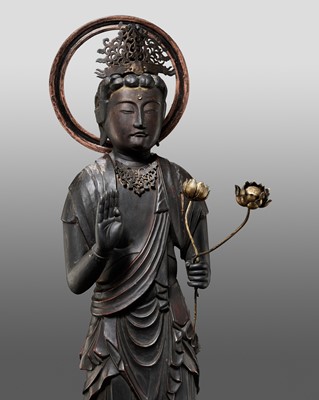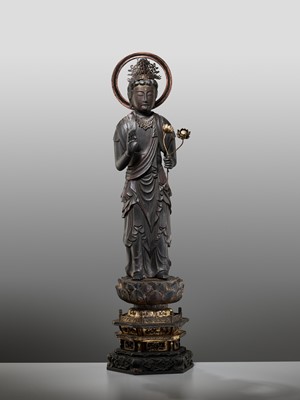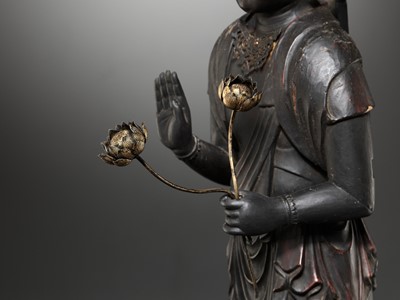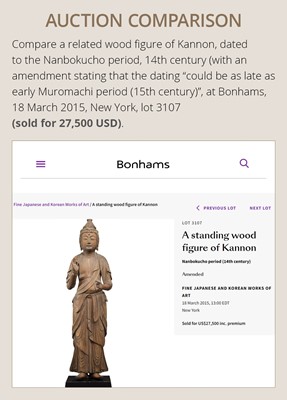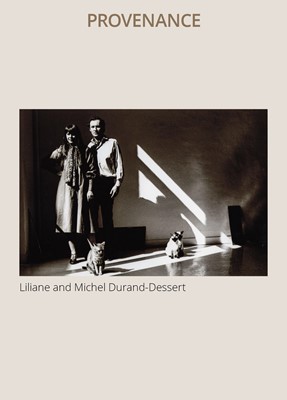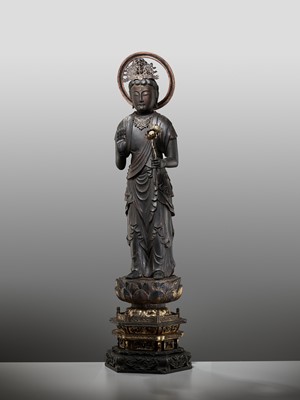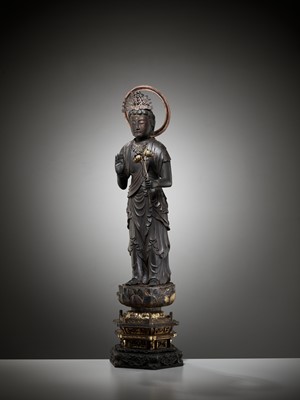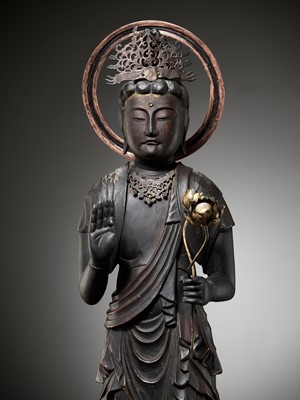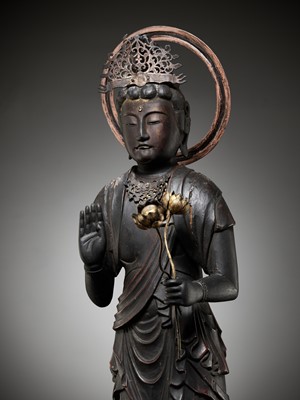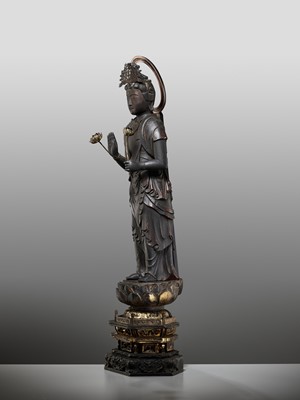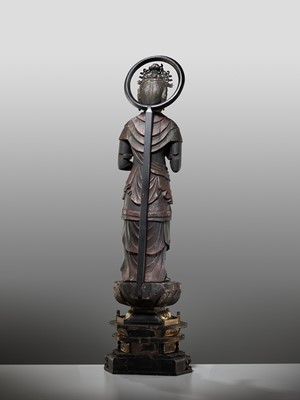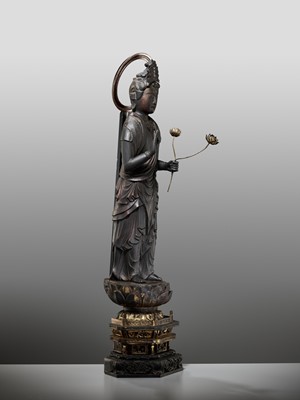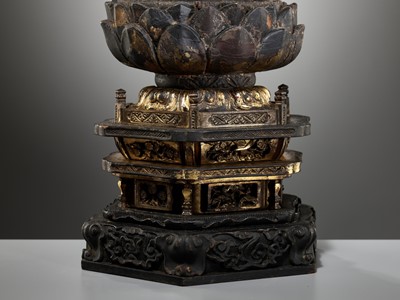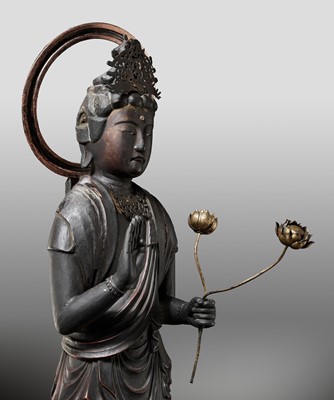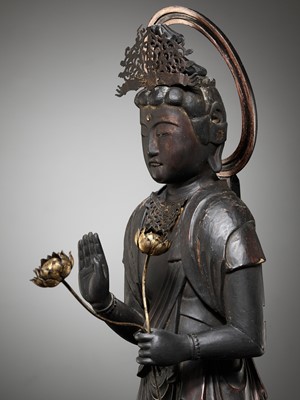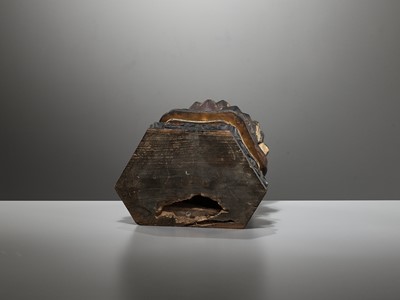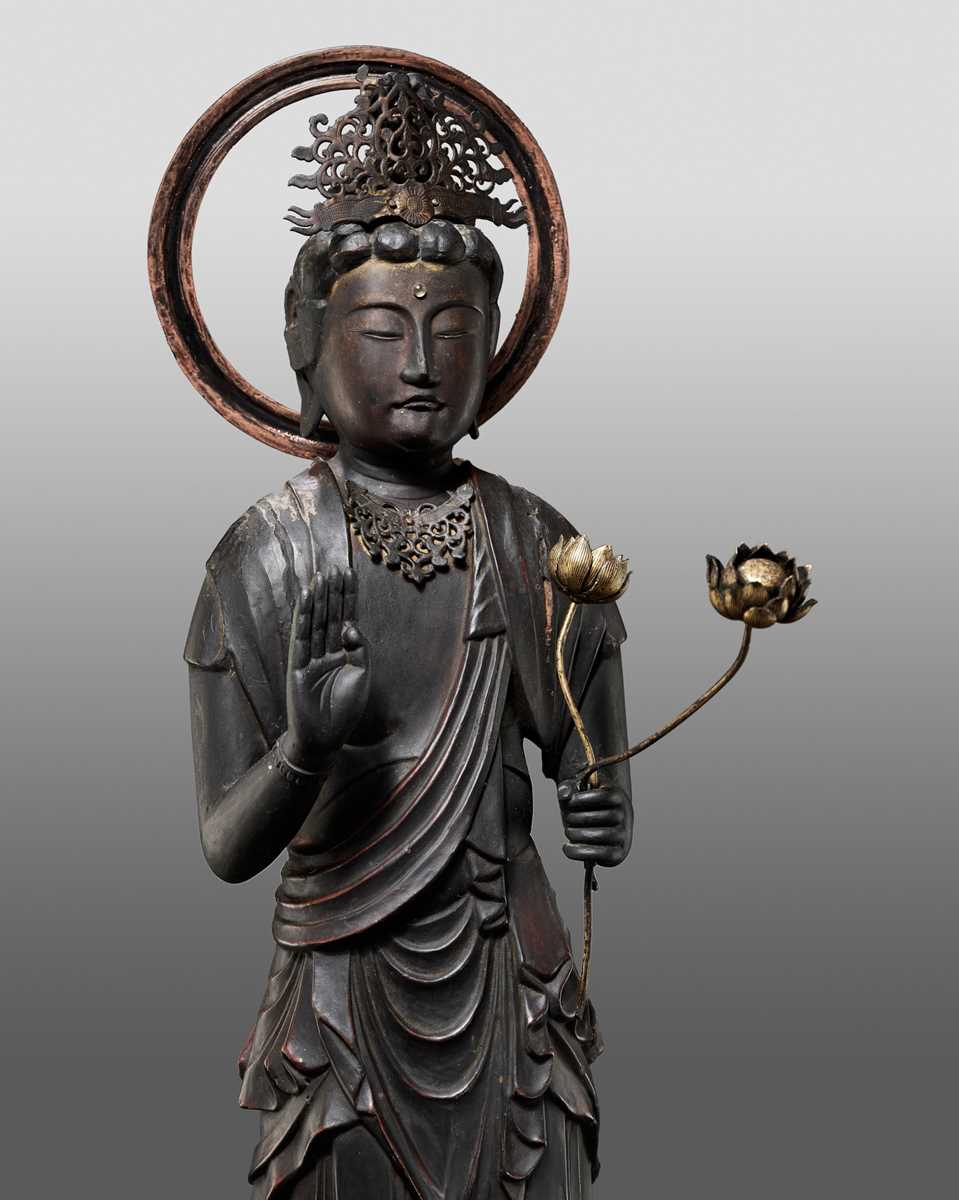1st Dec, 2023 13:00
Fine Japanese Art
37
A GILT AND LACQUERED WOOD FIGURE OF KANNON BOSATSU HOLDING LOTUS BLOSSOMS
Sold for €10,400
including Buyer's Premium
Japan, c. 1600, late Momoyama (1573-1600) to early Edo period (1615-1868)
Carved from cypress wood and assembled in yosegi-zukuri technique, the bodhisattva standing on a lotus dais supported on an elaborate tiered hexagonal pedestal carved with foliate, diapered, prunus, and cloud designs. The bodhisattva is wearing long flowing robes draped over both shoulders and with deeply carved folds. The right hand is held in semui-in (abhaya mudra) while the left holds two gilt-metal lotus blossoms borne on long stems. The serene face with heavy-lidded eyes below gently arched brows, centered by a glass or rock crystal byakugo (urna), further with full lips forming a subtle smile, flanked by long pierced pendulous earlobes. The hair piled in a topknot and adorned with a hokan (jeweled crown) and munakazari (ornamental necklace). The base inset with a flattened post surmounted by a circular halo.
HEIGHT 89 cm
Condition: Good condition with some wear, minor age cracks, small losses, minor flaking to lacquer, small chips. Rich, dark patina.
Provenance: Kyoto Gallery, Brussels, 21 March 2009. Liliane and Michel Durand-Dessert, Paris, acquired from the above. Liliane and Michel Durand-Dessert were luminous gallery owners who worked in Paris from 1975 to 2004, and were both informed and avant-garde collectors. They are significant not only because of the analytical and original approach the couple applied in each acquisition, but also because of their visionary take on exhibiting the most radical 20th-century art in their gallery, which was the subject of a 2004 retrospective organized by the Museum of Grenoble. According to Michel Durand-Dessert, who was inspired to open the couple’s first gallery by a visit to Documenta in 1968, “it is certain that a collection is a portrait, and that the objects we buy are those in which we sometimes recognize ourselves, sometimes we project ourselves. One way or another, acquiring them means adopting them, in every sense of the word.” An expertise from Kyoto Gallery, dated 21 March 2009, written and signed by Tony Cammaert, confirming the dating above, and stating a value for the present lot of 10,500 EUR, accompanies this lot.
Yosegi-zukuri, or joined wood-block construction, is a sculpting method in which several rectangular blocks of wood are individually selected and carved into shapes. Yosegi-zukuri, together with ichiboku-zukuri (single block construction), are the two main techniques associated with wood sculpture in Japan. There were several advantages to a sculpture made from multiple blocks of wood. It was much lighter than one carved out of a single block of wood. The technique also helped to minimize the cracking of the wood caused by the outside layer drying faster than the core of the sculpture.
Auction comparison:
Compare a related wood figure of Kannon, dated to the Nanbokucho period, 14th century (with an amendment stating that the dating “could be as late as early Muromachi period (15th century)”, at Bonhams, 18 March 2015, New York, lot 3107 (sold for 27,500 USD).
Japan, c. 1600, late Momoyama (1573-1600) to early Edo period (1615-1868)
Carved from cypress wood and assembled in yosegi-zukuri technique, the bodhisattva standing on a lotus dais supported on an elaborate tiered hexagonal pedestal carved with foliate, diapered, prunus, and cloud designs. The bodhisattva is wearing long flowing robes draped over both shoulders and with deeply carved folds. The right hand is held in semui-in (abhaya mudra) while the left holds two gilt-metal lotus blossoms borne on long stems. The serene face with heavy-lidded eyes below gently arched brows, centered by a glass or rock crystal byakugo (urna), further with full lips forming a subtle smile, flanked by long pierced pendulous earlobes. The hair piled in a topknot and adorned with a hokan (jeweled crown) and munakazari (ornamental necklace). The base inset with a flattened post surmounted by a circular halo.
HEIGHT 89 cm
Condition: Good condition with some wear, minor age cracks, small losses, minor flaking to lacquer, small chips. Rich, dark patina.
Provenance: Kyoto Gallery, Brussels, 21 March 2009. Liliane and Michel Durand-Dessert, Paris, acquired from the above. Liliane and Michel Durand-Dessert were luminous gallery owners who worked in Paris from 1975 to 2004, and were both informed and avant-garde collectors. They are significant not only because of the analytical and original approach the couple applied in each acquisition, but also because of their visionary take on exhibiting the most radical 20th-century art in their gallery, which was the subject of a 2004 retrospective organized by the Museum of Grenoble. According to Michel Durand-Dessert, who was inspired to open the couple’s first gallery by a visit to Documenta in 1968, “it is certain that a collection is a portrait, and that the objects we buy are those in which we sometimes recognize ourselves, sometimes we project ourselves. One way or another, acquiring them means adopting them, in every sense of the word.” An expertise from Kyoto Gallery, dated 21 March 2009, written and signed by Tony Cammaert, confirming the dating above, and stating a value for the present lot of 10,500 EUR, accompanies this lot.
Yosegi-zukuri, or joined wood-block construction, is a sculpting method in which several rectangular blocks of wood are individually selected and carved into shapes. Yosegi-zukuri, together with ichiboku-zukuri (single block construction), are the two main techniques associated with wood sculpture in Japan. There were several advantages to a sculpture made from multiple blocks of wood. It was much lighter than one carved out of a single block of wood. The technique also helped to minimize the cracking of the wood caused by the outside layer drying faster than the core of the sculpture.
Auction comparison:
Compare a related wood figure of Kannon, dated to the Nanbokucho period, 14th century (with an amendment stating that the dating “could be as late as early Muromachi period (15th century)”, at Bonhams, 18 March 2015, New York, lot 3107 (sold for 27,500 USD).
Zacke Live Online Bidding
Our online bidding platform makes it easier than ever to bid in our auctions! When you bid through our website, you can take advantage of our premium buyer's terms without incurring any additional online bidding surcharges.
To bid live online, you'll need to create an online account. Once your account is created and your identity is verified, you can register to bid in an auction up to 12 hours before the auction begins.
Intended Spend and Bid Limits
When you register to bid in an online auction, you will need to share your intended maximum spending budget for the auction. We will then review your intended spend and set a bid limit for you. Once you have pre-registered for a live online auction, you can see your intended spend and bid limit by going to 'Account Settings' and clicking on 'Live Bidding Registrations'.
Your bid limit will be the maximum amount you can bid during the auction. Your bid limit is for the hammer price and is not affected by the buyer’s premium and VAT. For example, if you have a bid limit of €1,000 and place two winning bids for €300 and €200, then you will only be able to bid €500 for the rest of the auction. If you try to place a bid that is higher than €500, you will not be able to do so.
Online Absentee and Telephone Bids
You can now leave absentee and telephone bids on our website!
Absentee Bidding
Once you've created an account and your identity is verified, you can leave your absentee bid directly on the lot page. We will contact you when your bids have been confirmed.
Telephone Bidding
Once you've created an account and your identity is verified, you can leave telephone bids online. We will contact you when your bids have been confirmed.
Classic Absentee and Telephone Bidding Form
You can still submit absentee and telephone bids by email or fax if you prefer. Simply fill out the Absentee Bidding/Telephone bidding form and return it to us by email at office@zacke.at or by fax at +43 (1) 532 04 52 20. You can download the PDF from our Upcoming Auctions page.
How-To Guides
How to Create Your Personal Zacke Account
How to Register to Bid on Zacke Live
How to Leave Absentee Bids Online
How to Leave Telephone Bids Online
中文版本的操作指南
创建新账号
注册Zacke Live在线直播竞拍(免平台费)
缺席投标和电话投标
Third-Party Bidding
We partner with best-in-class third-party partners to make it easy for you to bid online in the channel of your choice. Please note that if you bid with one of our third-party online partners, then there will be a live bidding surcharge on top of your final purchase price. You can find all of our fees here. Here's a full list of our third-party partners:
- 51 Bid Live
- EpaiLive
- ArtFoxLive
- Invaluable
- LiveAuctioneers
- the-saleroom
- lot-tissimo
- Drouot
Please note that we place different auctions on different platforms. For example, in general, we only place Chinese art auctions on 51 Bid Live.
Bidding in Person
You must register to bid in person and will be assigned a paddle at the auction. Please contact us at office@zacke.at or +43 (1) 532 04 52 for the latest local health and safety guidelines.
